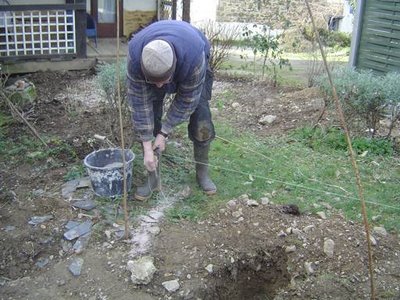
It’s been very dry recently; just 30mm of rain fell in January rather less than the average of 81mm. It has meant that we’ve been able to work outside a lot though and we’re making progress with the gite garden. The photo shows me using some wood ash (it was just what was to hand, sand would be just as good) and a length of string to mark out a curved bed, transferring the plan to the actual garden. It’s an interesting stage as, despite all the care and consideration that went into the planning, once it’s actually marked out in full scale in the garden itself, the proportions might seem wrong or the size for a particular item either too big or too small. And how did we deal with the concrete hard standing I told you about at the end of the lasts blog? I dug around and marked its limits with some canes, then measured up and transferred them to the plan, as an overlay on tracing paper (actually, it was greaseproof cooking paper) and we reconsidered the placing of certain features.
As we were keen on our original design, one solution might have been to hire a digger and driver to remove it all and then cart it down to the tip but that’s not a permaculture approach. Neither did it seem particularly “permaculture” to spend a lot of time digging up bits of it to place beds where we’d planned and then mixing concrete to form paths where there was good soil. A couple of things inspired us: an article in Permaculture Magazine issue 48 and an innovative reclamation of an old industrial site here in Brittany.
The article—Native Landscaping —describes Mark Fisher’s permaculture design at the Ecology Building Society’s new headquarters. Digging the ground to prepare for planting, he found all manner of junk and tells us, “recycling where I could, some had to go in the waste stream, but the tarmac, concrete and brick is neatly stacked and retained on site. I haven’t hidden it, but then I haven’t abdicated responsibility by skipping it so that it ends up polluting somewhere else. With time, moss will grow over it and the structural vegetation will obscure its presence. And since wild nature is often blind to our perversity, some creatures will probably find habitat and refuge in it.” One of the French woodland experts who came to our woods told me about a project—called Le Transformateur in the town of Redon, here in Brittany, where an old industrial site is being reclaimed as a public open amenity space using an interesting approach: “au Transformateur, les règles sont simples : faire avec tout ce qu'il y a sur place. Toute chose peut être une matière première…” Which is to say, “with the Transformer, the rules are simple: work with all that’s already there and that everything can be useful as raw material.”
So, without too much disruption, we’ve modified our plan and where we really want plants where the concrete is, we’ll smash a few drainage holes with a pickaxe, then put raised beds on top. Another part of the concrete slab will be home to a barbeque made from one of two old oil drums given to us by our French dairy farming friend, Yves (the other is going to be converted into a charcoal burner) and a cob pizza oven. Most of the path now runs over the concrete and there’s just a little to break up where we want to plant a living willow structure.
